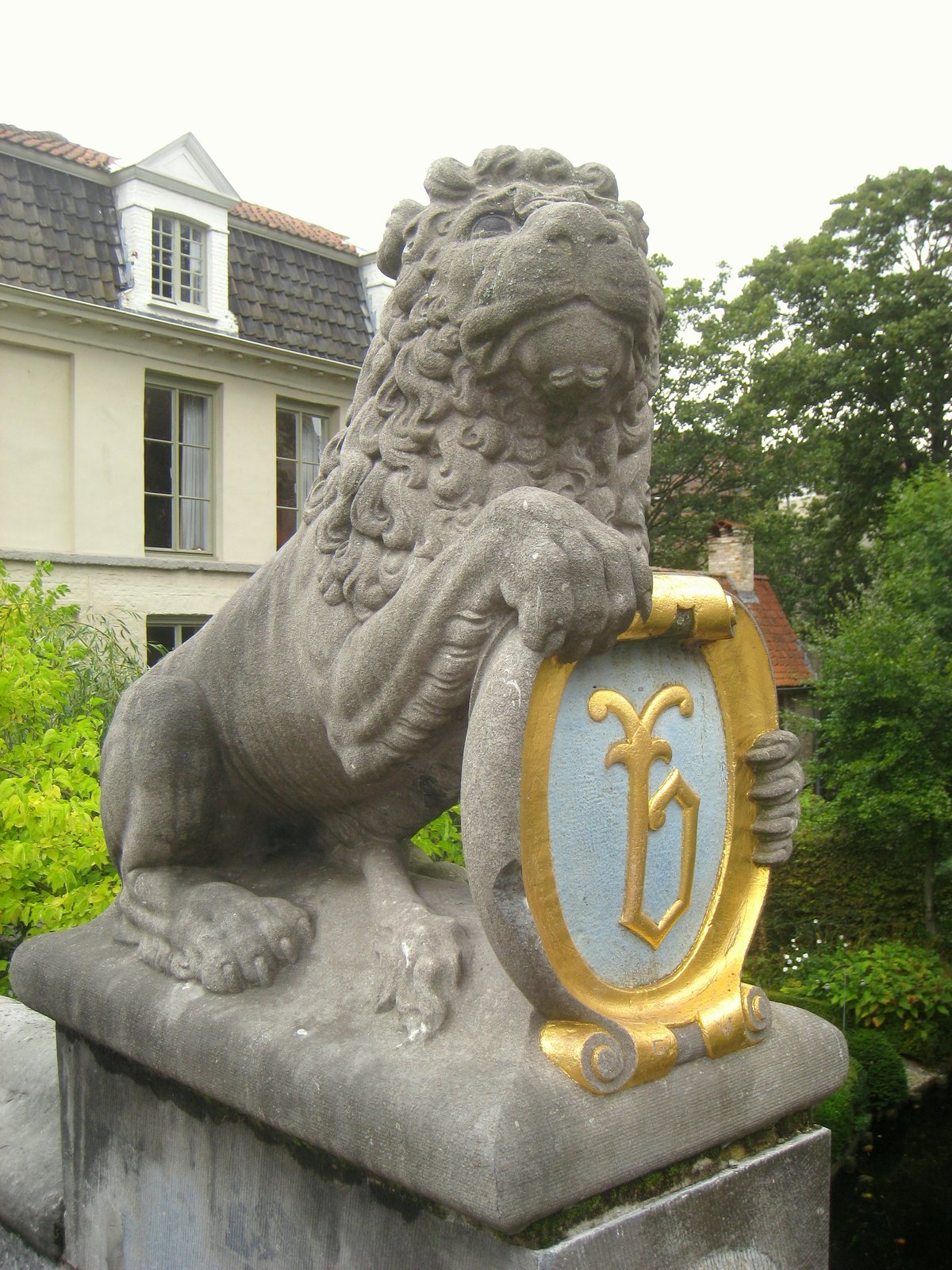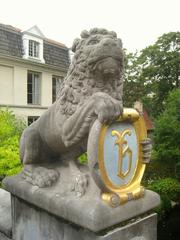
Leeuwenbrug (Lion’s Bridge) Bruges: Complete Visiting Guide
Date: 14/06/2025
Introduction
Leeuwenbrug, or Lion’s Bridge, is a historic stone bridge situated in the heart of Bruges’ UNESCO-listed medieval center. Renowned for its heraldic lion motifs and elegant arches spanning the Speelmansrei canal, Leeuwenbrug is both a functional crossing and a symbol of Bruges’ enduring cultural and architectural heritage. Freely accessible year-round and surrounded by the city’s picturesque canals and landmarks, this bridge is an essential stop for history enthusiasts, photographers, and casual visitors alike. This comprehensive guide details Leeuwenbrug’s history, architectural features, visiting hours, accessibility, nearby attractions, and practical travel tips to help you plan an unforgettable visit to one of Bruges’ most beloved sites.
For further details and official resources, see the Visit Bruges website, Wanderlog, and The Crazy Tourist.
Contents
- Medieval Bruges: Urban Development and the Role of Bridges
- Leeuwenbrug Origins and Historical Significance
- Architectural Features and Symbolism
- Visiting Leeuwenbrug: Hours, Tickets, and Accessibility
- Getting There: Transport and Location
- Nearby Attractions and Suggested Itinerary
- Practical Visitor Tips
- Leeuwenbrug in Local Culture and Events
- FAQ
- Summary & Recommendations
- Sources
Medieval Bruges: Urban Development and the Role of Bridges
Bruges flourished as a European trading hub from the 13th century, its economic success rooted in a complex network of canals and bridges. These waterways shaped commerce, defense, and daily life, earning the city the nickname “Venice of the North.” Bridges like Leeuwenbrug connected neighborhoods, markets, and fortifications, and each developed its own identity—often named for local guilds, symbols, or nearby landmarks (Bruges Day Tours, Wanderlog).
Leeuwenbrug Origins and Historical Significance
Constructed in the late Middle Ages, Leeuwenbrug’s origins reflect Bruges’ prosperity and urban growth. The bridge’s name, Dutch for “Lion’s Bridge,” references the lion sculptures or motifs that have long symbolized strength and civic unity in Flemish culture. Leeuwenbrug’s strategic placement facilitated movement between key city quarters, supporting trade and daily life. It may also have played a defensive role during times of conflict, as many medieval bridges were integral to Bruges’ fortifications (Waymarking, Traveltoer).
Architectural Features and Symbolism
Design and Structure
Leeuwenbrug is built from durable local sandstone, featuring low, gently arched spans over the canal. Its cobbled surface and stone balustrades harmonize with the surrounding medieval architecture, while decorative ironwork and commemorative plaques recall the bridge’s storied past (visitbruges.be). Though the original lion statues have been lost or replaced, the lion motif endures as a symbol of Flemish pride and Bruges’ independent spirit.
Integration with Urban Landscape
Leeuwenbrug connects Leeuwstraat to the city center, surrounded by green spaces and mature trees that enhance its romantic setting. Restoration efforts—especially during 20th-century urban renewal—have preserved the bridge’s historical character while ensuring safety and accessibility (visitbruges.be).
Visiting Leeuwenbrug: Hours, Tickets, and Accessibility
Visiting Hours
Leeuwenbrug is a public pedestrian bridge open 24 hours a day, year-round. No tickets or entry fees are required (The Crazy Tourist). Early mornings and late afternoons offer the most tranquil atmosphere and optimal lighting for photography.
Guided Tours
Many walking tours of Bruges’ historic center include Leeuwenbrug as a highlight, offering insights into its history and architectural context. Private and accessible tours can be arranged with local providers (Visit Bruges).
Accessibility
The bridge’s cobbled surface and gentle slopes are generally accessible, though they may pose challenges for wheelchair users or visitors with limited mobility. Some accessible routes and facilities are available nearby (Sage Traveling, Visit Bruges).
Getting There: Transport and Location
Leeuwenbrug’s central location makes it easily reachable:
- On Foot: A 10-minute walk from Markt (Market Square) or Burg Square through Bruges’ pedestrian-friendly streets (Eupedia).
- By Train: Bruges’ main station is 1.5 km from the center. Frequent buses and a free electric shuttle connect the station to central stops near Leeuwenbrug (Eupedia, Rambling Adventurista).
- By Bike: Numerous rental shops and flat terrain make cycling a pleasant option (Get Lost in Wanderlust).
- By Car: Parking is limited; use the Centrum Station car park and continue via public transport or on foot (The Discoveries Of).
See the Visit Bruges Map for precise location details.
Nearby Attractions and Suggested Itinerary
- Markt (Market Square): The vibrant heart of Bruges with the Belfry and cafes.
- Groeningemuseum: Flemish art masterpieces.
- Canal Boat Tours: Scenic rides departing near Leeuwenbrug.
- Sint-Jakobskerk (St James’s Church): Gothic architecture within walking distance.
- Sebrechtspark: Serene green space for relaxation.
- Brouwerij ‘De Halve Maan’: Brewery tours and tastings.
Combining a visit to Leeuwenbrug with these sites creates a rich, full-day itinerary.
Practical Visitor Tips
- Best Times: Early morning or dusk for fewer crowds and best photos.
- Footwear: Wear sturdy shoes to navigate cobblestones.
- Weather: Bring rain gear, as Bruges is often wet (Wanderlust Photos Blog).
- Amenities: Nearby cafes, restaurants, and shops offer local specialties and souvenirs.
- Language: Dutch (Flemish) is official, but English is widely spoken.
- Safety: Bruges is very safe; observe standard travel precautions.
Leeuwenbrug in Local Culture and Events
Leeuwenbrug often features in open-air concerts, art exhibitions, and city festivals. Its lion symbolism is woven into Bruges’ civic identity, and the bridge is a favorite site for artists, photographers, and romantic strolls (Visit Bruges). Programs like “Handmade in Bruges” promote local artisanship and sustainable tourism (ICH NGO Forum).
Frequently Asked Questions (FAQ)
Q: What are Leeuwenbrug’s visiting hours?
A: Open 24/7, year-round.
Q: Is there an entrance fee?
A: No, Leeuwenbrug is free for all visitors.
Q: Are guided tours available?
A: Yes, many walking tours include Leeuwenbrug; booking in advance is recommended.
Q: Is the bridge accessible for wheelchair users?
A: The cobblestone approach may be challenging; accessible routes and assistance are available.
Q: What can I visit nearby?
A: Market Square, Belfry, Groeningemuseum, canal boat tours, and local artisan shops.
Summary & Visitor Recommendations
Leeuwenbrug encapsulates Bruges’ medieval legacy and vibrant city life. Its enduring stone arches, symbolic lions, and central location make it a must-see for anyone exploring Bruges. Visit during quieter hours for the best experience, bring a camera, and consider a guided tour for deeper insights. Leeuwenbrug is not just a bridge—it is a living testament to Bruges’ history, culture, and ongoing preservation efforts.
For the latest updates on visiting hours, events, and accessibility, consult the Visit Bruges website. Enhance your trip with the Audiala app for self-guided tours and curated city content.
Sources and Further Reading
- Wanderlog — Best Bridges in Bruges
- Visit Bruges — Leeuwenbrug (Lion’s Bridge)
- Visit Bruges — Accessibility
- The Crazy Tourist — 15 Best Things to Do in Bruges
- Bruges Day Tours
- UNESCO World Heritage Centre — Bruges
- Waymarking — Leeuwenbrug
- Sage Traveling — Bruges Accessibility Guide
- Eupedia — Bruges Guide
- Rambling Adventurista — Ultimate Travel Guide to Bruges
- Get Lost in Wanderlust — Is Bruges Worth Visiting?
- The Discoveries Of — Bruges Map
- ICH NGO Forum — Handmade in Bruges Case Study
- Emily Embarks — One Day in Bruges











































































